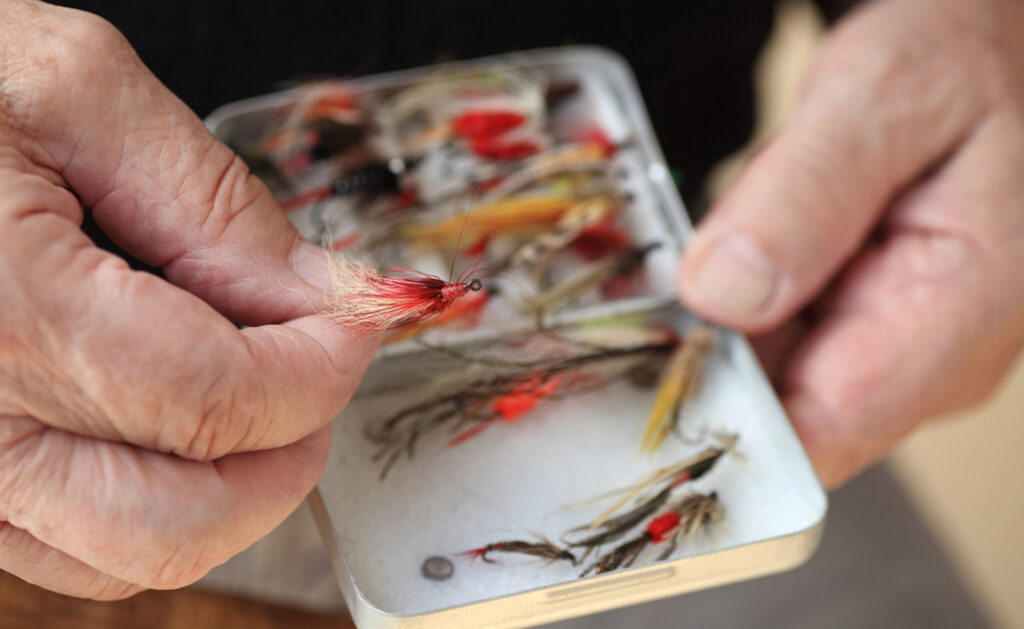
What Inbound Marketing and Fly-Fishing Have in Common
What’s the difference between traditional and inbound marketing? Traditional marketing is like trawling – you know, fishing by trailing a net through the water. When you trawl, you get fish, but you get a lot of other things too. Say you’re trawling for a specific species of fish; you throw out your net, drag it behind your boat and later haul up the net.
So, you cast a wide net and managed to snag a few of the fish you were looking for, but you caught a bunch of other stuff too. Turtles, perhaps. Dolphins, maybe. Trash, probably. That’s traditional (outbound) marketing: Cast a wide net and hope you get the right customer buried among the wrong customers. By wrong, I mean the ones who aren’t interested in what you have to offer.

Enter inbound marketing. If traditional marketing is trawling, inbound marketing is fly fishing. In fly fishing, you create the right fly for the right location and the right fish. Fly fishing is deliberate and targeted. You’re not dropping a net on the fish and trapping them haphazardly; you’re setting up a situation where they come to you. When you trawl, the fish see the net coming and yell, “Run! Run!” When you’ve tied on the right fly and cast it perfectly, the fish says, “A Woolly Bugger! Nom nom!” The fish come to you. They bite; you reel ‘em in and keep them (marketing is NOT catch-and-release).
When you tie flies, you take your fur, feathers, thread and hook to create something compelling to bring the fish to you. With inbound marketing, you’re doing the same thing – except your marketing fly-tying materials are blogs, SEO, web pages and social media sprinkled with calls to action, email and landing pages. You’re casting, attracting, hooking and landing – and possibly sautéing in a bit of butter with an excellent Chardonnay on the side.

So, you pick your fish, create something it wants, and put it out there. That’s inbound marketing: Instead of shouting, you’re studying, listening, and targeting to get the fish you want. And by fish, I mean customers. You’re getting the customers who want to buy your product.
Now consider this:
- Inbound marketing costs 61% less per lead than traditional, outbound marketing (HubSpot).
- 54% more leads are generated by inbound tactics than traditional paid marketing (HubSpot)
Here’s what marketer Guy Kawasaki has to say about inbound marketing:
“If you have more money than brains, you should focus on outbound marketing. If you have more brains than money, you should focus on inbound marketing.”
So, what is inbound marketing?
Inbound marketing is commonly defined as “publishing the right content in the right place at the right time.” Your content, whether a blog, ebook, email or social media post, is relevant to your audience. You know your audience because you’ve created buyer personas, and you know the right time because you’ve done A/B testing and you’ve worked at nurturing leads. You continue nurturing them after they become customers.
That last piece is important: After you get a customer, you want to continue to delight them so that they become repeat customers – after all, it’s about seven times more expensive to get a new customer than to keep an existing one. And existing customers tend to spend more, so it’s a win-win.
There’s no doubt that inbound is effective, but as with everything, marketing is constantly evolving, and inbound is also changing. At the same time, it’s essential to know that traditional marketing isn’t dead, and you shouldn’t throw it out the window. Inbound and outbound can play nicely together, and a mix of the two is likely more effective than putting all your eggs in one basket. You might have to reallocate some budget until you find the right combination for your company or product.
It all comes down to what you’re trying to accomplish and what you’re trying to sell – and to whom. There’s no one-size-fits-all because everyone is different. After all, you wouldn’t use a Kinky Muddler to catch a salmon, right?
What’s the difference between traditional and inbound marketing? Traditional marketing is like trawling – you know, fishing by trailing a net through the water. When you trawl, you get fish, but you get a lot of other things too. Say you’re trawling for a specific species of fish; you throw out your net, drag it behind your boat and later haul up the net.
So, you cast a wide net and managed to snag a few of the fish you were looking for, but you caught a bunch of other stuff too. Turtles, perhaps. Dolphins, maybe. Trash, probably. That’s traditional (outbound) marketing: Cast a wide net and hope you get the right customer buried among the wrong customers. By wrong, I mean the ones who aren’t interested in what you have to offer.

Enter inbound marketing. If traditional marketing is trawling, inbound marketing is fly fishing. In fly fishing, you create the right fly for the right location and the right fish. Fly fishing is deliberate and targeted. You’re not dropping a net on the fish and trapping them haphazardly; you’re setting up a situation where they come to you. When you trawl, the fish see the net coming and yell, “Run! Run!” When you’ve tied on the right fly and cast it perfectly, the fish says, “A Woolly Bugger! Nom nom!” The fish come to you. They bite; you reel ‘em in and keep them (marketing is NOT catch-and-release).
When you tie flies, you take your fur, feathers, thread and hook to create something compelling to bring the fish to you. With inbound marketing, you’re doing the same thing – except your marketing fly-tying materials are blogs, SEO, web pages and social media sprinkled with calls to action, email and landing pages. You’re casting, attracting, hooking and landing – and possibly sautéing in a bit of butter with an excellent Chardonnay on the side.

So, you pick your fish, create something it wants, and put it out there. That’s inbound marketing: Instead of shouting, you’re studying, listening, and targeting to get the fish you want. And by fish, I mean customers. You’re getting the customers who want to buy your product.
Now consider this:
- Inbound marketing costs 61% less per lead than traditional, outbound marketing (HubSpot).
- 54% more leads are generated by inbound tactics than traditional paid marketing (HubSpot)
Here’s what marketer Guy Kawasaki has to say about inbound marketing:
“If you have more money than brains, you should focus on outbound marketing. If you have more brains than money, you should focus on inbound marketing.”
So, what is inbound marketing?
Inbound marketing is commonly defined as “publishing the right content in the right place at the right time.” Your content, whether a blog, ebook, email or social media post, is relevant to your audience. You know your audience because you’ve created buyer personas, and you know the right time because you’ve done A/B testing and you’ve worked at nurturing leads. You continue nurturing them after they become customers.
That last piece is important: After you get a customer, you want to continue to delight them so that they become repeat customers – after all, it’s about seven times more expensive to get a new customer than to keep an existing one. And existing customers tend to spend more, so it’s a win-win.
There’s no doubt that inbound is effective, but as with everything, marketing is constantly evolving, and inbound is also changing. At the same time, it’s essential to know that traditional marketing isn’t dead, and you shouldn’t throw it out the window. Inbound and outbound can play nicely together, and a mix of the two is likely more effective than putting all your eggs in one basket. You might have to reallocate some budget until you find the right combination for your company or product.
It all comes down to what you’re trying to accomplish and what you’re trying to sell – and to whom. There’s no one-size-fits-all because everyone is different. After all, you wouldn’t use a Kinky Muddler to catch a salmon, right?

Recent Comments